| Second World War | |||||
|---|---|---|---|---|---|
| Part of Operation Stonewall of the Atlantic campaign | |||||
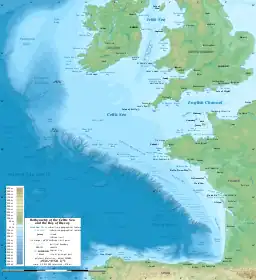 The Bay of Biscay | |||||
| |||||
Operation Stonewall was an Allied naval and air operation in the Second World War from 26 to 27 December 1943, to intercept blockade-runners sailing to German-occupied France through the Bay of Biscay. Operations Barrier and Freecar, by the Allied navies and the Brazilian Air Force, had taken place in the south- and mid-Atlantic. The ships were tracked by OP-20-G (US Navy) and British (Government Code and Cypher School (GC&CS) at Bletchley Park) code-breakers, which decrypted Japanese machine cyphers and German Enigma machine transmissions to U-boats (Shark cypher) and blockade-runners (Sunfish cypher).
At the west end of the Bay of Biscay, Royal Navy and Allied ships, with Coastal Command aircraft of Operation Stonewall hunted the blockade-runners, assisted by convoy Escort Groups and support groups diverted from nearby convoys. Orsono and Alsterufer were the first two blockade-runners of the late-1943 – early-1944 season. Orsono evaded interception and was escorted into the estuary of the Gironde by German destroyers and torpedo boats (small destroyers).
On 27 December, Osterufer was spotted by a fighter from an American escort carrier, then attacked by Australian, British and Canadian, Coastal Command, Sunderland flying boats but suffered little damage. At 4:07 p.m. Liberator GR Mk V "H" of 311 (Czech) Squadron made a low-altitude attack on Alsterufer with rockets and bombs, setting the ship on fire. Alsterufer sank the next day and 74 survivors were rescued 48 hours later by Canadian corvettes.
The German destroyers and torpedo boats that had escorted Orsono to port sailed to rendezvous with Alsterufer, the Germans being unaware of the bombing of the ship. Using Enigma decrypts of their positions, the German ships were bombed by US Liberators and then intercepted by the cruisers HMS Glasgow and Enterprise of Operation Stonewall. In the Battle of the Bay of Biscay one of the destroyers and two torpedo boats were sunk during a severe storm. Sailings of blockade-runners from France were cancelled and three runners from Japan were sunk by the US Navy in the south Atlantic in January 1944.
Background
Allied blockade of Germany
From the start of the war on 3 September 1939, the Allies proclaimed a blockade of Germany to prevent the import of goods. Germany had no rubber, oil, tin and tungsten. Until Operation Barbarossa the German invasion of the Soviet Union, it evaded the blockade via the Trans-Siberian Railway. After the was closed at the start of Barbarossa and after the Japanese entry into the war, German and Italian ships were stranded in Japan and Japanese-occupied Singapore. The ships were used as blockade-runners to ports in occupied France after mid-1940 when Germany had taken control of the European coast from Norway to the French–Spanish border. From April 1941 to May 1942, 32 ships tried to reach France and 14 succeeded.[1] From August 1942 to April 1943 fifteen ships tried to run the blockade and four got through.[2]
Ultra (cryptography)
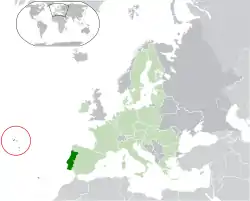
The defeat of the German U-boat offensive in the Battle of the Atlantic in 1943 was followed by the last attempt by the Germans to pass blockade-runners through the Bay of Biscay to and from the Japanese empire. From May 1943 decrypts of Japanese diplomatic wireless traffic revealed to the Allies that the losses of the 1942–1943 had not deterred the Axis from making another attempt in the autumn. Seven merchant ships were to sail from Europe carrying 50,000 long tons (51,000 t) of exports and that the Germans were building special U-boats to import 3,000 long tons (3,000 t) of goods from Japan in 1943. In July and August, photographic reconnaissance and agent reports from the French Atlantic ports that sailings for the far East were being prepared and by 6 September it was clear that seven ships were close to sailing.[3]
On 4 October, after the blockade-runner Kulmerland had been hit by bombers, a signal from the Japanese Ambassador in Berlin showed the Allies that the export programme had been cut to 35,000 long tons (36,000 t) because of the Allied bombing.[3] On 18 July the British and Portuguese reached a basing agreement for the Azores, which came into force on 8 October and which had the potential to deter the Axis from trying to run the blockade.[4] On 23 October, the Germans introduced new W/T methods for signalling between U-boats and blockade-runners in the Bay of Biscay and in early November Dresden, thought to be a blockade-runner, struck a mine. The British thought that five ships were preparing to leave the Bay and that four ships were preparing in the Far East. Later in November, another decrypt from the Japanese Ambassador revealed that the German export programme had been reduced again, to 29,000 long tons (29,000 t). US Navy patrols in the South Atlantic has been increased.[5]
Prelude
Operations Barrier and Freecar
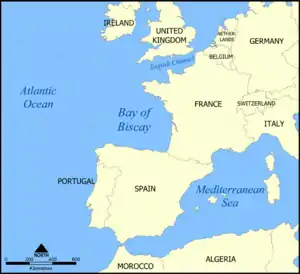
Evidence that the new round of departures from the Far East had begun was found in an Ultra decrypt of 16 November, prohibiting U-boat attacks west of a line in the south Atlantic. The Naval and air commanders were told that a northbound blockade-runner and possibly another eight were approaching, including Osorno and Alsterufer. Little was revealed by OP-20-G, the US Navy (USN) code-breaking organisation, until 26 November, that on the day before the U-boat restrictions in the south Atlantic had been imposed further north on 1 December.[6][lower-alpha 1] On 26 November the Italian ship Pietro Orseolo sailed from Bordeaux to Concarneau on the south Brittany coast and was attacked by aircraft from Coastal command on 1 December to no effect.[7]
Operation Barrier began with Task Force 41 (TF.41) comprising five task groups, with a cruiser and a destroyer each and USN aircraft patrols from Natal, with Brazilian Air Force patrols from Recife (at war with Germany and Italy since 22 August 1942) and flights by USN patrol bombers from Ascension Island on 1 December.[6] Operation Freecar began soon after Barrier with the armed merchant cruisers HMS Corfu and Cilicia, the French cruiser Suffren and the Italian cruisers Abruzzi and d'Aosta.[6] The first blockade-runner en route to Europe was Osorno 6,951 GRT (Captain Hellmann) which sailed from Kobe on 2 October, disguised as the British ship Prome, rounding the Cape of Good Hope on 15 November.[6] More information was received by the Allies on 5 December that the restrictions were in force north of the equator from the next day.[8]
The ship was spotted on 8 December by Liberator B-8 of VPB-107 from Ascension but TG.41.4 (the cruiser USS Marblehead and the destroyer Winslow) found only a Greek ship.[6] The Admiralty signalled the importance given to preventing the arrival of blockade-runners on 12 December and the Royal Navy light cruiser HMS Glasgow left on patrol from the Azores.[8] Searches to the north-west found nothing but Orsono was sighted by U-510 whose sighting report was decrypted by OP-20-G on 13 December; Barrier and Freecar were suspended, letting the refrigerated cargo ship (reefer) Alsterufer (Captain Piatek, 2,170 GRT) pass unseen.[6] On 18 December, a Sunfish message sent on 13 December to Osorno and Asterufer was decrypted and on 22 December a decrypt of the U-boat Shark cypher showed that the U-boat restrictions were in force west of the Bay of Biscay.[8]
Operation Stonewall
Plymouth Command
Coastal Command prepared a force of Halifax and Liberator bombers to attack the blockade-runners as they crossed the Bay of Biscay. The Royal New Zealand Navy (RNZN) light cruiser HMNZS Gambia, recently refitted, arrived at Plymouth from Scotland on 5 December 1943. Gambia was to join Glasgow and Enterprise under the command of the Commander-in-Chief Plymouth (Admiral Ralph Leatham) for operations against blockade runners.[9] U-boats were sailing in distant waters which required more signals from Befehlshaber der U-Boote (U-boat Command) about blockade-runners. The Shark cypher for U-boats was often being decrypted quickly by the Government Code and Cypher School (GC&CS) which then broke the Sunfish Enigma key used by the blockade-runners.[5]
Orsono
| Code | Route |
|---|---|
| ON | Outward North (UK to US) |
| HX | Halifax to UK |
| SC | Sydney/Halifax/New York to UK |
| GUS | Port Said to US Slow |
| UGS | US to Port Said/Gibraltar |
| KMF | UK to Mediterranean Fast |
| MKS | Mediterranean to UK Slow |
| SL | Freetown to UK |
| CU | Curaçao/New York to UK (tankers) |
| KMS | UK to Mediterranean Slow |
| OS | Outbound South (UK to Freetown) |
After the first blockade-runner managed to pass the Natal–Freetown narrows, Leatham began Operation Stonewall. Gambia and Glasgow sailed from Plymouth to Horta in the Azores taking turns to patrol, fuelling from a tanker at Horta. From 16 to 17 December, Osorno crossed the US to Gibraltar convoy route undetected.[11] Coastal Command sent six Torbeau torpedo-bombers of 254 Squadron and six Beaufighters of 248 Squadron for Flak suppression, escorted eight Typhoon fighters, attacked the outbound Pietro Orseolo on 18 December, hitting it amidships twice with torpedoes; the ship exploded and sank off Lorient the next morning.[12] On 19 December Osorno passed through the US–UK route near Convoy ON 215, following a day behind Convoy HX 270 and a day in front of Convoy SC 149.[13]
Alsterufer crossed the US–Gibraltar route on 20 December, not far from TG.21.16, which included the carrier USS Block Island and four destroyers.[13] Alsterufer was behind the westbound Convoy GUS 23 and near the eastbound Convoy UGS 27.[13] From 21 to 22 December, Osorno turned east for the Bay of Biscay and crossed the paths of Convoy KMF 27 and Convoy MKS 33/SL 142, which was accompanied by Escort Group B4 and a support group based on HMS Fencer. Wolfpack Borkum, was formed from the southernmost boats of Wolfpack Coronel to attack Convoy MKS 33/SL 142 to cover the return of Osorno.[13][lower-alpha 2]
TG.21.15, comprising the escort carrier USS Core with four destroyers, detached from Convoy GUS 24 and TG.21.14, with the escort carrier Card and three destroyers, hunted Wolfpack Borkum, which was assisted by five FW 200 Kondor bombers flying by day, a BV 222 flying boat on the night of 20/21 December and more aircraft during the next day but no ships were sunk.[13] German aircraft reported the escort carrier groups three times on 22 and 23 December.[13] Gambia and Glasgow were behind Osorno; Alsterufer was distant from Convoy CU 9 to the east, TG.21.16 to the south-east and Convoy SC 149 to the north.[11] On 23 December, a F4F fighter from Card sighted a suspect ship, which was Osorno about 500 nmi (930 km; 580 mi) south-west of Ushant but the aircraft lost track of the ship in bad weather.[13][lower-alpha 3] During the evening of 24 December, Convoy OS 62/KMS 36 from the north with Escort Group B1 and the support group of the escort carrier HMS Striker ran into Wolfpack Borkum and U-415 sank HMS Hurricane with a T5 torpedo.[15]
Unternehmen Bernau
At noon on 24 December, the 8. Zerstörerflotille (8th Destroyer Flotilla, Captain Erdmenger) Z 27, Z 23, Z 24, Z 32, Z 37 and ZH 1 with the 4. Torpedobootsflottille (4th Torpedo Boat Flotilla, Korvettenkapitän Franz Kohlauf) with T 22, T 23, T 24, T 25, T 26 and T 27 began Unternehmen Bernau by departing from the Biscay ports to rendezvous with Osorno and escort it to port. From dawn on 25 December, Sunderland flying boats from 201 Squadron RAF, 422 Squadron RCAF and 461 Squadron RAAF, were in contact with the German escort force but the rendezvous with Osorno was made after the destroyers had shot down a Sunderland. Attacks by aircraft of 19 Group Coastal Command were thwarted by anti-aircraft fire from the ships and long-range Ju 88 fighters sent by Fliegerführer Atlantik. Osorno reached the Gironde estuary, then ran into the wreck of Seprrbrecher 21 and had to be beached at Le Verdon-sur-Mer at the entrance to the estuary.[16] Bomber Command sent five Stirling bombers out mine-laying on the night of 29/30 December and the waters around the ship were mined, to obstruct the unloading of its cargo of rubber but the Germans got most of it ashore.[17]
Alsterufer
Unternehmen Trave
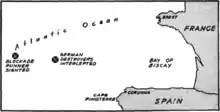
The 8. Zerstörerflotille and the 4. Torpedobootsflottille less ZH 1, which had engine-trouble, sailed into the Bay of Biscay again on Unternehmen Trave (Operation Beam) on 26 December to meet Alsterufer and escort it into the Gironde.[18]
Sinking of Alsterufer
Just before 10:00 a.m. on 27 December Alsterufer was spotted by Sunderland "T" of 201 Squadron, about 500 nmi (930 km; 580 mi) north-west of Cape Finisterre. Captain Piatek, of 'Alsterufer', broke radio silence and requested support. Piatek was concerned about discipline amongst the crew, because they had hoped to make port before Christmas and he had refused to allow them to sample any of the 6,000 bottles of beer on board, to avoid the rigours of the Bay of Biscay crossing "with a tipsy crew". During the morning, 'Alsterufer' was attacked by Sunderland "Q" of 422 Squadron RCAF and "U" of 201 Squadron flown by Leslie Baveystock who wrote later,
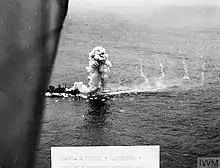
By the time we had spotted the ship we were down to 200 feet with our quarry dead ahead in what should have been an ideal position. If I released our bombs we just couldn’t miss, but their forward speed, being the same as that of our aircraft, would have resulted in explosions directly under us, with the consequent dire damage to ourselves. This I could not risk.[19]
the gunners strafed 'Alsterufer' and the Sunderland climbed to 1,000 ft (300 m) bombing and depth-charging by radar to little effect. Baveystock "cursed the stupid Armaments Office for not giving us delay fuses on our bombs, as he should have done".[19][lower-alpha 4] The Luftwaffe and Kriegsmarine promised aircraft and destroyers but not the ships until the next morning.[20] The light cruiser Enterprise to the east of Alsterufer and Glasgow 300 nmi (560 km; 350 mi) to the west, were ordered to make their best speed to a point 300 nmi (560 km; 350 mi) north-west of Cape Finisterre.[18]
At 4:07 p.m. Liberator GR Mk V "H" of 311 (Czech) Squadron, sighted Alsterufer.[21][lower-alpha 5] The Liberator made a diving attack through the anti-aircraft fire of 'Alsterufer' and fired its eight wing-mounted, semi-armour piercing (SAP60) rocket projectiles. Five of the rockets hit the ship above the waterline and a 500 lb (230 kg) bomb and a 250 lb (110 kg) bomb hitting the ship aft of the funnel, killing two sailors and setting the ship on fire.[21] Alsterufer had opened fire with anti-aircraft guns and parachute-and-cable rockets, hitting the Liberator's starboard outer engine but the aircraft returned to base at RAF Beaulieu in England. Four hours later, two Liberators of 86 Squadron finished off the ship. Alsterufer sank on the afternoon of 28 December. Four lifeboats with 74 survivors were picked up two days later by four Canadian corvettes.[22][lower-alpha 6]
Battle of the Bay of Biscay
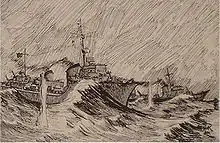
Gambia departed from Faial Island in the Azores on 27 December, its Captain, William Powlett, being made commander of Force 3, the ships already at sea, the light cruiser Penelope and the fast minelayer Ariadne from Gibraltar and the Free French large destroyers, Le Fantasque and Le Malin from the Azores.[18]The Allied cruiser captains were told that about a dozen German destroyers could be on the way to rendezvous with the blockade runner.[18] Naval Group West did not find out about the loss of Alsterufer until morning on 28 December and cancelled Unternehmen Bernau, ordering the ships to return. The flotilla was spotted by a US Liberator of VPB-105 and attacked by fifteen more Liberators from that squadron and VPB-103, which enabled Glasgow and Enterprise to intercept them at noon.[24]
The eleven ships of the flotilla had twenty-five 150 mm and twenty-four 105 mm guns against the nineteen 6-inch and thirteen 4-inch guns of the cruisers. The German flotilla and tried to attack the cruisers from both flanks but the stormy seas prevented the ships from sailing at their maximum speed. Z 27 (Captain Günther Schultz, with the flotilla commander, Captain Erdmenger, aboard), T 25 and T 26 were sunk. Z 24, T 23, T 24 and T 27 returned to Brest; Z 32, and Z 37 got to the Gironde and Z 23 with T 22, which had turned south, made port at St Jean de Luz. Sixty-four survivors were rescued by Royal Navy minesweepers, 168 by the Irish coaster, Kerlogue, six by Spanish destroyers and 55 by German submarine U-505 and German submarine U-618. Glasgow, Enterprise and Ariadne returned to Plymouth under glider-bomb attack and Penelope, Le Fantasque and Le Malin to Gibraltar. Gambia and Mauritius patrolled north of the Azores for blockade-runners until 1 January.[25]
Aftermath
Analysis
Morale in the Kriegsmarine was depressed further with the news that the battleship Scharnhorst had been sunk on 26 December at the Battle of the North Cape.[26] Osorno was the last blockade-runner to reach port, its cargo of rubber meeting German needs until November 1944.[27] In 1984, Harry Hinsley wrote in the official history of British intelligence in the war that the defeat of the German destroyer flotilla, like the sinking of Scharnhorst, could only have happened because the Admiralty was receiving decrypts of Enigma messages almost as quickly as their German addressees. The engagement also finally made the Admiralty admit that the German Type 1936A destroyers (Narvik-class to the British) carried 6 in (150 mm) guns.[28]
Casualties
Three men on Alsterufer were killed and 74 were rescued.[29] Of the 672 men on the three German warships, 93 were rescued from Z27, 100 from T25 and 90 from T26.[30] About 62 survivors were picked up by British minesweepers, 168 were rescued by Kerlogue a small Irish steamer and four by Spanish destroyers.[31] In 2003, Gerhard Koop and Klaus-Peter Schmolke wrote that there were 740 men in the three ships and that 293 men survived, 21 rescued by U-618, 34 by U-505, six by Spanish destroyers, 64 by British minesweepers and 168 by an Irish merchant ship.[32]
Subsequent operations
The last three blockade-runners, Weserland, Burgenland and Rio Grande were known to the Allied through decrypts of their sailings from the Far East. US naval forces intercepted them in the south Atlantic from 3 to 5 January 1944. After another nine days, Sunfish decrypts revealed that the Germans did not know of the interceptions and had ordered two of their blockade-runners to prepare to sail. On 21 January it was discovered that all four blockade-runners preparing for the voyage top the Far East had been ordered to stand down because of the risk of interception.[28][lower-alpha 7]
Orders of battle
- Ships: Canadian, French, New Zealand, United Kingdom, United States
- Aircraft: United Kingdom (including one with Czechoslovak crew), United States
Notes
- ↑ The sailing of five blockade runners had been revealed to US code-breakers by the Purple and Bertok/Barnacle cyphers.[6]
- ↑ Wolfpack Coronel was operating further north and Borkum comprised U-801, U-107, U-667, U-618, U-270, U-541, U-645, U-962, U-415, U-305, U-275, U-382 and U-641.[13]
- ↑ During the night of 23/24 December U-305 sighted TG.21.14 but was deterred by one of the destroyers, which detected it with HF/DF. U-415 fired three FAT (Flächenabsuchender Torpedo [area searching torpedo]) at Card but missed and also missed a destroyer with a G7es torpedo (T5). U-645 missed a destroyer with a T5 and was sunk by depth charges; U-275 hit the destroyer Leary with a T5 and it was sunk by a torpedo from U-382; TG.21.14 had to withdraw because of fuel shortage.[14]
- ↑ Baveystock headed for base Castle Archdale in Northern Ireland but short of fuel, landed near St Mary's in the Scilly Isles.[19]
- ↑ Captain, Pilot Officer Oldřich Doležal with Sergeant Robert Prochazka, co-pilot, Flying Officer Zdeněk Hanuš, Navigator/Bomb Aimer, Warrant Officer Josef Kosek, Air Gunner, Flight Sergeant Jindřich Hahn, Radar Operator/Air Gunner, Flight Sergeant Marcel Ludikar, Wireless Operator/Air Gunner, Flight Sergeant Ivan Schwarz, Wireless Operator/Air Gunner and Sergeant František Veitl, Flight Engineer.[21]
- ↑ The survivors gave great praise to the Czech Liberator crew who had flown "unperturbed through the heaviest barrage".[23]
- ↑ After the war it was found that Dönitz had suggested to Hitler on 18 January 1944 that blockade-running be cancelled.[33]
Footnotes
- ↑ Roskill 1957, pp. 64–65, 551–552.
- ↑ Roskill 1962, pp. 273, 4483–484.
- 1 2 Hinsley 1984, p. 247.
- ↑ Roskill 1960, pp. 46–47.
- 1 2 Hinsley 1984, pp. 247–248.
- 1 2 3 4 5 6 7 Rohwer & Hümmelchen 2005, p. 290.
- ↑ Roskill 1960, p. 74.
- 1 2 3 Hinsley 1984, pp. 248–249.
- ↑ Roskill 1960, pp. 72–73.
- ↑ Hague 2000, pp. 109–114.
- 1 2 Rohwer & Hümmelchen 2005, p. 292.
- ↑ Nesbit 2000, p. 123.
- 1 2 3 4 5 6 7 8 Rohwer & Hümmelchen 2005, p. 293.
- ↑ Rohwer & Hümmelchen 2005, pp. 293–294.
- ↑ Rohwer & Hümmelchen 2005, p. 294.
- ↑ Rohwer & Hümmelchen 2005, p. 294; Saunders 1975, p. 71.
- ↑ Roskill 1960, pp. 73–74.
- 1 2 3 4 Rohwer & Hümmelchen 2005, p. 295; Waters 1956, p. 354.
- 1 2 3 McKinstry 2023, p. 204.
- ↑ Saunders 1975, pp. 70–71.
- 1 2 3 Vančata 2013, p. 64.
- ↑ Vančata 2013, p. 64; Rohwer & Hümmelchen 2005, p. 295.
- ↑ Saunders 1975, p. 71.
- ↑ Rohwer & Hümmelchen 2005, p. 295.
- ↑ Waters 1956, p. 355; Rohwer & Hümmelchen 2005, p. 295.
- ↑ Whitley 1983, pp. 193–199.
- ↑ Müller 2003, p. 581.
- 1 2 Hinsley 1984, p. 251.
- ↑ Waters 1956, p. 354.
- ↑ O'Hara 2004, pp. 277–279.
- ↑ Waters 1956, p. 355; Whitley 1983, pp. 193–199.
- ↑ Koop & Schmolke 2014, p. 104.
- ↑ Hinsley 1984, pp. 251–252.
References
- Hague, Arnold (2000). The Allied Convoy System 1939–1945. London: Chatham. ISBN 1-86176-147-3.
- Hinsley, F. H.; Thomas, E. E.; Ransom, C. F. G.; Knight, R. C. (1984). British Intelligence in the Second World War, Its Influence on Strategy and Operations (Part I). History of the Second World War. Vol. III (1st ed.). London: HMSO. ISBN 0-11-630935-0.
- Koop, Gerhard; Schmolke, Klaus-Peter (2014) [2003]. German Destroyers of World War II. Translated by Brooks, Geoffrey (Repr. Eng. trans. ed.). Barnsley: Seaforth Publishing, Pen & Sword. ISBN 978-1-84832-193-9. Translated from Die deutschen Zerstörer 1939–1945 Bernard & Graefe Verlag, Bonn (1995). Originally published in English by Greenhill books, Lionel Leventhal (2003)
- Kroener, Bernhard R.; Müller, Rolf-Dieter; Umbreit, Hans (2003) [1999]. Organization and Mobilization of the German Sphere of Power: Part 2 Wartime administration, economy and manpower resources1942–1944/5. Germany and the Second World War. Vol. V. Translated by Cook-Radmore, Derry; Osers, Ewald; Smerin, Barry; Wilson, Barbara (Eng. trans. Clarendon Press, Oxford ed.). Stuttgart: Deutsche-Verlags-Anstalt GMBH for Militärgeschichtliches Forschungsamt (Research Institute for Military History) Potsdam, Germany. ISBN 0-19-820873-1.
- Müller, Rolf-Dieter. "Part II Albert Speer and Armaments Policy in Total War, III Basic Conditions of Wartime Production, and Civilian Factors. 4, Organization and Exploitation of 'Fortress Europe'. (c) The Decline in Wartime Foreign Trade (xiii) Japan". In Kroener, Müller & Umbreit (2003).
- McKinstry, Leo (2023). Cinderella Boys: The Forgotten RAF Force that Won the Battle of the Atlantic (e-book ed.). London: John Murray. ISBN 978-1-5293-1938-5.
- Nesbit, Roy Conyers (2000) [1997]. RAF Coastal Command in Action 1939–1945 (repr. Budding Books, Stroud ed.). Cheltenham: Sutton Publishing. ISBN 1-84015-112-9.
- O'Hara, Vincent P. (2004). The German Fleet at War, 1939–1945. Annapolis, Maryland: Naval Institute Press. ISBN 1-59114-651-8.
- Rohwer, Jürgen; Hümmelchen, Gerhard (2005). Chronology of the War at Sea 1939–1945: The Naval History of World War Two (3rd rev. ed.). Annapolis, Maryland: Naval Institute Press. ISBN 1-59114-119-2.
- Roskill, S. W. (1957) [1954]. Butler, J. R. M. (ed.). The War at Sea 1939–1945: The Defensive. History of the Second World War United Kingdom Military Series. Vol. I (4th impr. ed.). London: HMSO. OCLC 881709135. Archived from the original on 27 February 2022.
- Roskill, S. W. (1962) [1957]. The War at Sea 1939–1945: The Period of Balance. History of the Second World War. Vol. II (3rd impr. ed.). London: HMSO. OCLC 174453986. Retrieved 4 June 2018 – via Hyperwar.
- Roskill, Stephen (1960). Butler, J. R. M. (ed.). The War at Sea 1939–1945: The Offensive Part I 1st June 1943 – 31st May 1944. History of the Second World War United Kingdom Military Series. Vol. III. London: HMSO. OCLC 987392618.
- Saunders, H. St George (1975) [1954]. Royal Air Force 1939–45: The Fight is Won. Vol. III (pbk. repr. HMSO ed.). London: HMSO. ISBN 978-0-11-771594-3.
- Vančata, Pavel (2013). 311 Squadron. Sandomierz: Stratus, for Mushroom Model Publications. ISBN 978-83-61421-43-6.
- Waters, S. D. (1956). "Chapter 23, The New Zealand Cruisers". Royal New Zealand Navy (online scan). The Official History of New Zealand in the Second World War 1939–1945 (New Zealand Electronic Text Collection ed.). Wellington: Historical Publications Branch. pp. 352–356. OCLC 173284131.
- Whitley, M. J. (1983). Destroyer!: German Destroyers in World War II. London: Arms & Armour Press. ISBN 978-0-85368-258-5.
Further reading
- Blair, Clay (2000) [1998]. Hitler's U-Boat War: The Hunted 1942–1945. Vol. II. London: Cassell. ISBN 0-304-35261-6.
- Lambert, Andrew (1986). Warship. Vol. X. Naval Institute Press. ISBN 978-0-85177-449-7.
- Morison, Samuel (1947). The Battle of the Atlantic 1939–1943. History of United States Naval Operations in World War II. Vol. I. Boston: Little, Brown and Co. OCLC 162633216 – via Archive Foundation.
- Oldfield, Paul (2013). Cockleshell Raid. Battleground: French Coast. Barnsley: Pen & Sword. ISBN 978-1-78159-255-7.
- Šulc, Jiří (2011). Operace Stonewall (in Czech). Prague: Knižní klub. ISBN 978-80-242-5788-4.